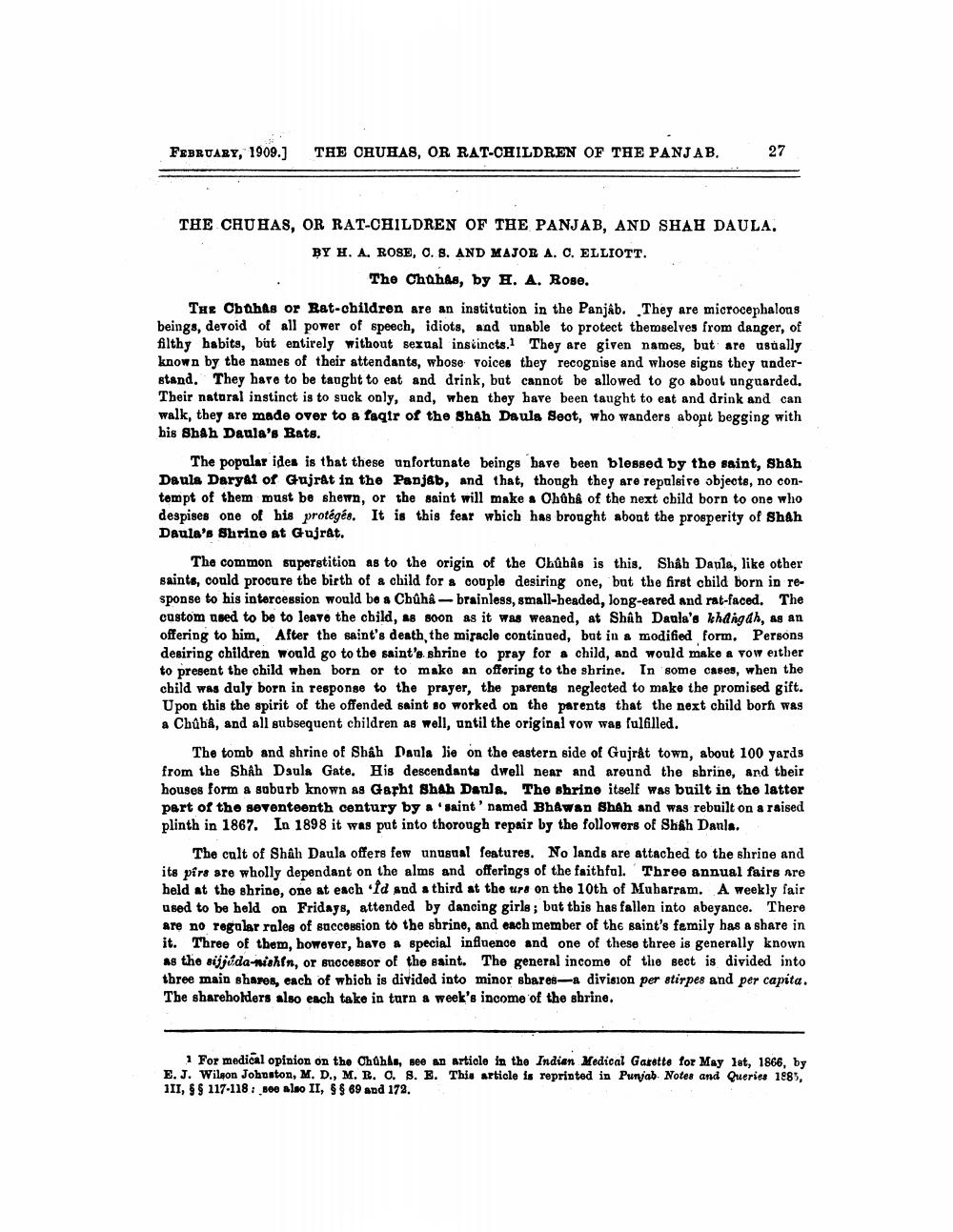________________
FEBRUARY, 1909.)
THE CHUHAS, OR RAT-CHILDREN OF THE PANJAB.
27
THE CAUHAS, OR RAT-CHILDREN OF THE PANJAB, AND SHAH DAULA.
BY U. A. ROSE, O. 8. AND MAJOR A. C. ELLIOTT.
The Chuhas, by H. A. Rose. The Cbahas or Bat-children are an institution in the Panjab. They are microcephalous beings, devoid of all power of speech, idiots, and unable to protect themselves from danger, of filthy habits, but entirely without sexual instincts. They are given names, but are usually known by the names of their attendants, whose voices they recognise and whose signs they understand. They have to be taught to eat and drink, but cannot be allowed to go about unguarded. Their natural instinct is to suck only, and, when they have been taught to eat and drink and can walk, they are made over to a faqir of the Shah Daula Seot, who wanders about begging with his Shah Daula's Bats.
The popular idea is that these unfortunate beings have been blessed by the saint, Shah Dauls Daryat of Gujrat in the Panjab, and that, though they are repulsire objects, no contempt of them must be shewn, or the saint will make a Ohaba of the next child born to one who despises one of his protégés. It is this fear which has brought about the prosperity of Shah Daula's Shrine at Gujrat.
The common superstition as to the origin of the Ohthis is this. Shab Daula, like other saints, could procure the birth of a child for a couple desiring one, but the first child born in response to his intercession would be a Chûhâ-brainless, small-headed, long-eared and rat-faced. The custom used to be to leave the child, As soon as it was weaned, at Shah Daula's khangdh, ag an offering to him. After the saint's death the miracle continued, but in a modified form. Persons desiring children would go to the saint's shrine to pray for a child, and would make a vow either to present the child when born or to make an offering to the shrine. In some cases, when the child was duly born in response to the prayer, the parents neglected to make the promised gift. Upon this the spirit of the offended saint so worked on the parents that the next child born was a Chûbå, and all subsequent children as well, until the original vow was fulfilled.
The tomb and shrine of Shah Danla lie on the eastern side of Gujrat town, about 100 yards from the Shah Daula Gate. His descendants dwell near and around the shrine, and their houses form a suburb known as Gachi Shah Danla. The shrine itself was built in the latter part of the seventeenth century by a saint' named Bhawan Shah and was rebuilt on a raised plinth in 1867. In 1898 it was put into thorough repair by the followers of Shah Danla.
The cult of Shih Daula offers few unusual features. No lands are attached to the shrine and its pirs are wholly dependant on the alms and offerings of the faithful. Three annual fairs are held at the shrine, one at each Id and a third at the urs on the 10th of Muharram. A weekly fair used to be held on Fridays, attended by dancing girls; but this has fallen into abeyance. There are no regalar rales of succession to the sbrine, and each member of the saint's family has a share in it. Three of them, however, have a special influence and one of these three is generally known As the sijjáda nishin, or successor of the saint. The general income of the sect is divided into three main shares, each of which is divided into minor sbares-a division per stirpes and per capita. The shareholders also each take in turn a week's income of the shrine.
For medical opinion on the Ohaha, see an article in the Indian Medical Gazette for May 1st, 1866, by E.J. Wilson Johnston, M. D., M. R. O. B. E. This article is reprinted in Punjab Notes and Queries 1885, III, & $ 117-118 : 300 also II, $$ 69 and 172.




